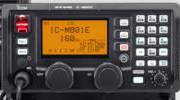Introduction
Marine Radio Communication is a part of the international radio
communication allocated to specific marine usage.
In contrast to Amateur Radio, it offers some special services
related to typical marine issues such as emergency communication
and traffic control communication.
However, also the different Maritime Mobile Amateur Radio Networks offer a lot of information for mariners. In order to participate in Amateur Radio Networks, a separate licence must be obtained, that will allow to transmit on the frequency bands allocated to Amateur Radio. These bands include the popular 20-m band, which is very well suited for long-range communications during daylight conditions. Unfortunately, there are no maritime channels available in this band.  Maritime Radio communications is conducted in a fixed frequency channel grid, whereas
Radio Amateurs can choose an arbitrary frequency within the allocated frequency bands.
Despite these different technical approaches, some manufacturers offer transceivers that
allow to work on both maritime and amateur radio bands.
Maritime Radio communications is conducted in a fixed frequency channel grid, whereas
Radio Amateurs can choose an arbitrary frequency within the allocated frequency bands.
Despite these different technical approaches, some manufacturers offer transceivers that
allow to work on both maritime and amateur radio bands.In coastal range, cellular telephones can offer an additional way of ship-to-shore communication, but this system cannot be a replacement for the required marine safety communication systems. More specific cellular telephones generally cannot provide ship-to-ship safety communication nor communication with marine rescue installations. |
| Cover << Sail Away << Marine Radio Communication << . | . >> Regulations | last updated: 26-Feb-2012 |